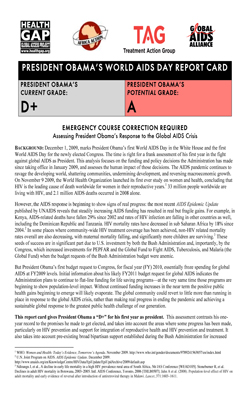EMERGENCY COURSE CORRECTION REQUIRED
Assessing President Obama’s Response to the Global AIDS Crisis
December 1, 2009, marks President Obama’s first World AIDS Day in the White House and the first World AIDS Day for the newly elected Congress. The time is right for a frank assessment of his first year in the fight against global AIDS as President. This analysis focuses on the funding and policy decisions the Administration has made since taking office in January 2009, and assesses the human impact of those decisions. The AIDS pandemic continues to ravage the developing world, shattering communities, undermining development, and reversing macroeconomic growth. On November 9 2009, the World Health Organization launched its first ever study on women and health, concluding that HIV is the leading cause of death worldwide for women in their reproductive years.1 33 million people worldwide are living with HIV, and 2.1 million AIDS deaths occurred in 2008 alone.
However, the AIDS response is beginning to show signs of real progress: the most recent AIDS Epidemic Update published by UNAIDS reveals that steadily increasing AIDS funding has resulted in real but fragile gains. For example, in Kenya, AIDS-related deaths have fallen 29% since 2002 and rates of HIV infection are falling in other countries as well, including the Dominican Republic and Tanzania. HIV mortality rates have decreased in sub Saharan Africa by 18% since 2004.2 In some places where community-wide HIV treatment coverage has been achieved, non-HIV related mortality rates overall are also decreasing, with maternal mortality falling, and significantly more children are surviving.3 These seeds of success are in significant part due to U.S. investment by both the Bush Administration and, importantly, by the Congress, which increased investments for PEPFAR and the Global Fund to Fight AIDS, Tuberculosis, and Malaria (the Global Fund) when the budget requests of the Bush Administration budget were anemic.
But President Obama’s first budget request to Congress, for fiscal year (FY) 2010, essentially froze spending for global AIDS at FY2009 levels. Initial information about his likely FY2011 budget request for global AIDS indicates the Administration plans to continue to flat-line funding for life saving programs—at the very same time those programs are beginning to show population-level impact. Without continued funding increases in the near term the positive public health gains beginning to emerge will likely evaporate. The global community could revert to little more than running in place in response to the global AIDS crisis, rather than making real progress in ending the pandemic and achieving a sustainable global response to the greatest public health challenge of our generation.
This report card gives President Obama a “D+” for his first year as president.

